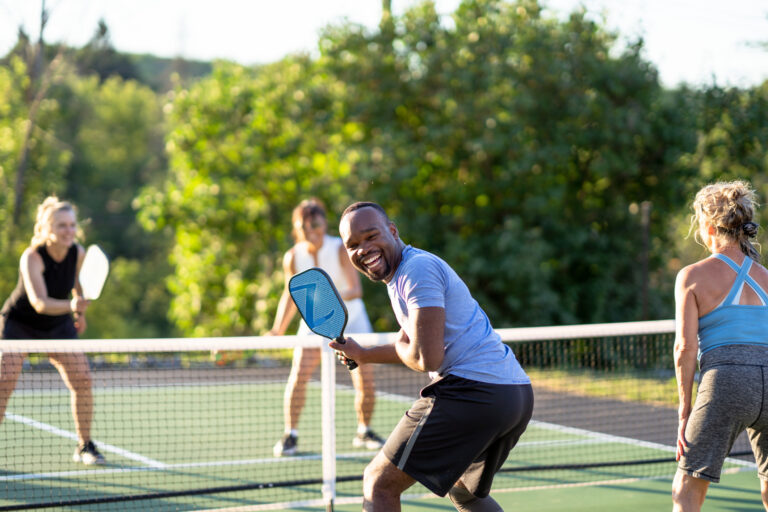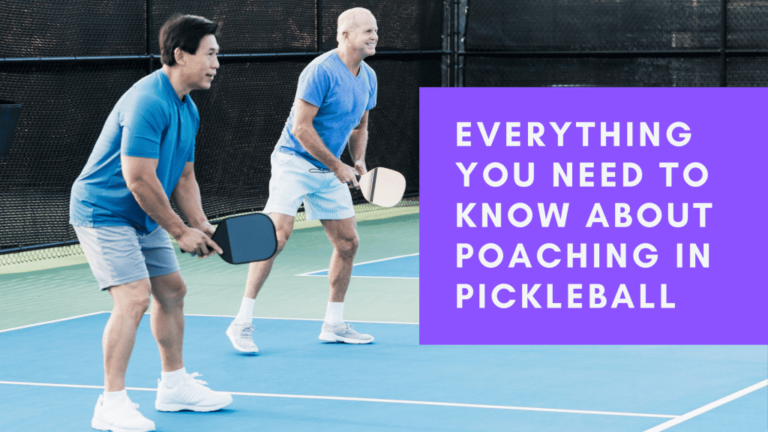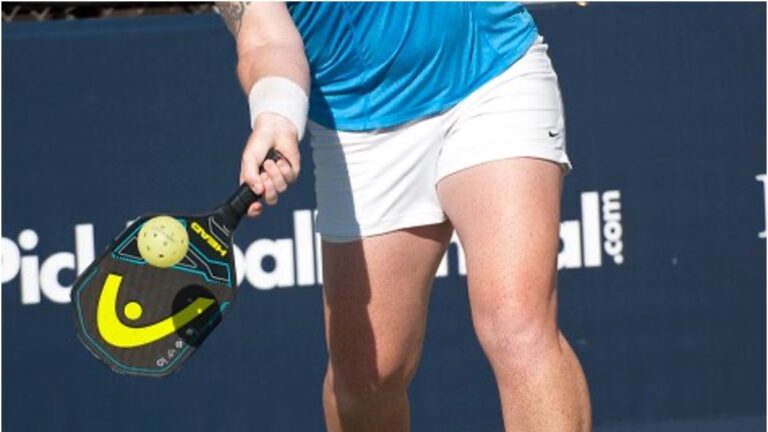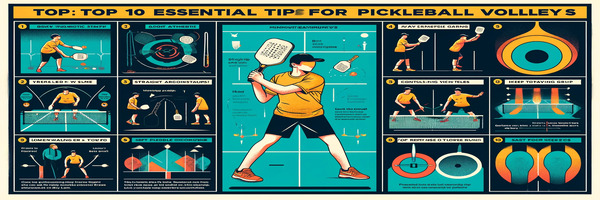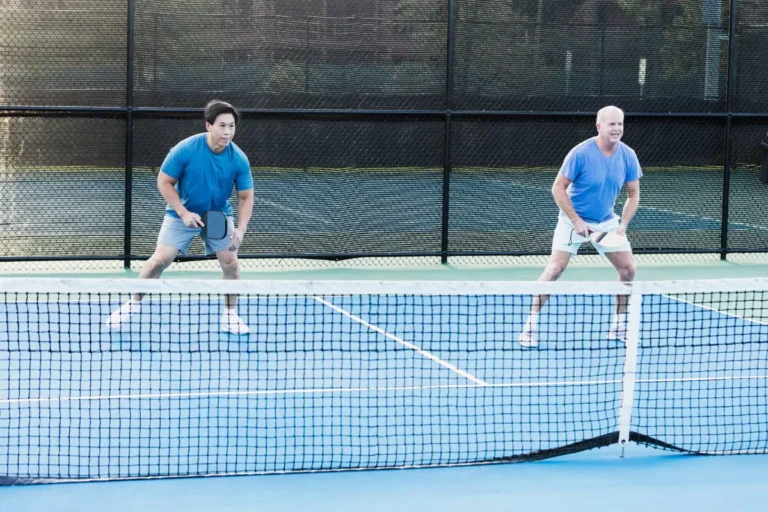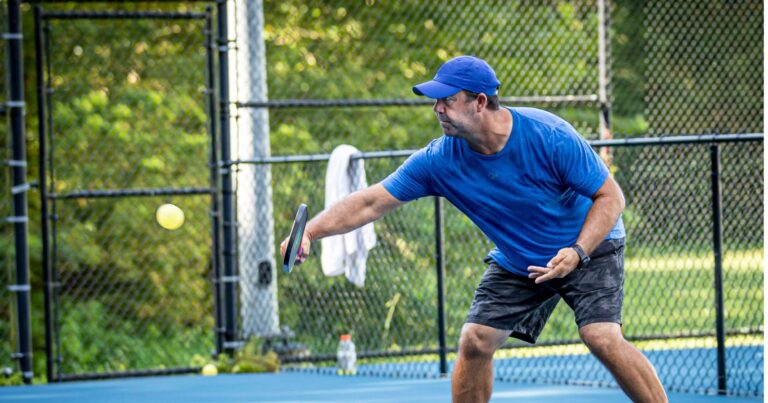Advanced Pickleball Strategy: Tips and Tactics for Success
In pickleball, your success hinges on your strategy. Smart positioning and shot selection, alongside effective teamwork, give you the upper hand. Focus on consistent serving and return shots to control the game’s flow. Utilize clever footwork for better court coverage and efficient movement. Use your knowledge regarding your opponents’ weak points to your advantage. Apply pressure, keep them guessing, but also cultivate patience. Remember, clear and timely communication is key in doubles, so work on verbal and non-verbal signals. With these insights, you’re well on your way to mastering pickleball. Ready to elevate your game to the next level?
Main Points
- Mastering serve and return shots is crucial for controlling the game and creating scoring opportunities.
- Proper footwork enhances balance, agility, and speed, impacting both offensive and defensive play.
- Analyzing opponents’ positioning and tendencies helps in making the right shot selections for strategic play.
- Applying pressure on opponents’ weak areas and having patience in shot placement can control the pace of the game.
- Effective team communication, including verbal calls and non-verbal signals, is key to success in pickleball.
Understanding Basic Pickleball Strategy
To master the art of pickleball, you’ll need to grasp basic strategy components like positioning, shot selection, and partner communication as these are essential in controlling the game. It’s about making smart decisions and precisely placing your shots to exploit your opponent’s weaknesses and minimize unforced errors.
The first step in your strategy should be maintaining good court coverage. This means always being aware of your position, moving efficiently, and staying ready to react to any shot. Remember, the objective is to cover the most court area with the least amount of movement.
Shot selection is the next key factor in your pickleball strategy. It’s not just about hitting the ball hard; it’s about selecting the right shot at the right time to keep your opponents off balance.
Communication with your partner is equally important. Always call out your shot intentions, coordinate your movements, and provide positive feedback to each other. It strengthens your team dynamics and contributes to better court coverage.
Mastering Your Serve
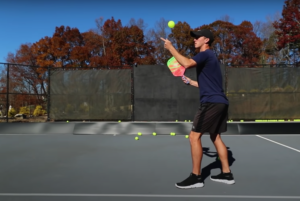
Moving from team dynamics to individual skills, let’s not overlook the importance in mastering your serve in pickleball, as it’s a powerful tool that can set the tone for the entire point. Your serve can impose pressure on your opponents, and it’s where consistency and placement come into play.
- Mastering your serve starts with achieving consistency. The more consistent your serves, the more you can maintain control over the game.
- Placement is critical. Practice serving to different locations on the court. By keeping your opponents guessing, you’ll add an extra layer of pressure.
- Diversity is key. Develop various types of serves such as topspin, slice, and flat serves. Each has unique advantages and can disrupt your opponents’ rhythm.
- Finally, use your serve as a weapon to create scoring opportunities. A well-placed serve can set you up for a winning shot.
Perfecting Return Shots
In pickleball, perfecting your return shots can greatly improve your game and keep your opponents guessing. One way to keep your opponents on their toes is by focusing on returning deep shots. This strategy prevents opponents from gaining the upper hand as they’ll have to move further back to make a return.
Aiming for the sidelines and corners also helps create difficulty for your opponents. It forces them to stretch and scramble, reducing their chances of making a clean, controlled return. Don’t shy away from experimenting with varying shot angles and speeds. It’s a surefire way to keep your opponents guessing and off balance, giving you a clear advantage.
Targeting the middle of the court is another smart strategy. It forces your opponents to make tough decisions on shot selection, often leading to errors. Plus, it’s an excellent method to disrupt opponents’ communication and coordination.
Lastly, remember that consistency is key. Regular practice will help you maintain control and dictate the pace of the game. By consistently hitting your shots, you’ll be more likely to achieve your desired shot speeds and angles, establishing dominance over your opponents.
Importance of Footwork
While perfecting your return shots delivers a strong edge, don’t overlook the role that proper footwork plays in pickleball – it’s a game-changer that amplifies your agility, balance, and speed on the court. Good footwork isn’t just about moving swiftly; it’s about moving smartly. It enables you to cover the court more effectively, positioning yourself better for shot execution. It also allows for smoother shifts, whether you’re volleying at the net or retrieving a deep serve.
Consider the following points to understand the importance of footwork:
** Proper footwork enhances balance and agility, allowing you to reach the ball quickly and efficiently.
It aids in court coverage**, helping you to be in the right place at the right time.
- Effective footwork impacts shot execution, letting you position yourself effectively for volleys and groundstrokes.
- It supports change between offensive and defensive play, enhancing your overall gameplay.
Incorporating footwork practice into your training regimen can drastically improve your pickleball skills. Remember, it’s not just about hitting the ball; it’s about moving to hit the ball. So, invest time in perfecting your footwork, and watch your game soar to new heights.
Making Right Shot Selections
Often, your success in pickleball hinges on making the right shot selections. It’s not just about hitting the ball; it’s about making strategic decisions that keep your opponents off balance. Analyzing your opponents’ positioning can help determine your next move.
Consider the court situation, your skill level, and your partner’s position. If your opponents are close to the net, for instance, a deep shot can push them back. If they’re far from the line, a short, precise hit might just do the trick. Remember, it’s not always about power; sometimes, a gentle touch is more effective.
Adapt your shots based on the score, your opponents’ tendencies, and the flow of the game. As time goes by, you’ll start noticing patterns that can help fine-tune your strategy. Consistency is important; you’d rather make ten moderate shots than one spectacular one that ends up out of bounds.
Lastly, keep your opponents guessing. If you’re always hitting the same shots, they’ll easily adapt. Mix it up. Change the speed, spin, and direction of the ball. In the end, the right shot selection can give you the upper hand in pickleball.
Exploiting Opponents’ Weaknesses
In pickleball, you must learn to exploit your opponents’ weaknesses to gain the upper hand.
This involves keen observation to identify weak spots, making targeted shot selections, and applying pressure forcefully yet strategically.
Identifying Weak Spots
To gain the upper hand in pickleball, start by observing your opponents’ shot patterns to identify their weaker side. Pay close attention to their footwork, backhand, reaction time, and shot placements. Vulnerabilities often come to light within these areas.
Here are a few tactics you can employ:
- Exploit slow footwork by hitting wide angles. This forces opponents to move quickly, often throwing them off balance.
- If their backhand seems less consistent or powerful, make it your target.
- Mix up your shot placements and speeds to test their reaction time. This may reveal hidden weaknesses.
- Employ high balls, overhead shots, and lobs if they struggle with these. It’s a simple yet effective strategy to keep them guessing and on the defensive.
Targeted Shot Selection
By consistently targeting your opponent’s backhand side, you can exploit weaker returns and create opportunities for winning shots. This strategic play capitalizes on their vulnerabilities, particularly if it’s their non-dominant side.
Also, directing shots behind your opponent disrupts their positioning, forcing them to hustle, which opens up the court for your targeted shot selection.
Consider aiming at your opponent’s feet too, as this can lead to awkward footwork, limiting their ability to make strong counterattacks. Leveraging such tactics keeps your opponents off balance, allowing you to control the pace the game and dictate the flow the rally.
Forceful Pressure Application
While targeted shot selection is a powerful tool, it’s equally important to apply relentless pressure on your opponents by exploiting their weaknesses. For instance, if your rivals struggle with backhand shots, focus your attacks there. Or, if their footwork is less than stellar, use shot placement to exploit these vulnerabilities.
Here’s how you can apply forceful pressure:
- Keep varying your shot selection and angles to keep your opponents off balance.
- Identify their weak areas and attack relentlessly, making them uncomfortable.
- Use strategic shot placement to dominate rallies.
- Control the pace the game, forcing them to play at your tempo.
The Art of Patience
In the game of pickleball, mastering the art can greatly enhance your performance, allowing you to wait for the right moments to strike and gain the upper hand. Instead, patience involves biding your time, making strategic decisions that maintain control over rallies and minimize unforced errors. This isn’t always easy and requires a calm and composed mindset, particularly under pressure.
Patience also leads to better positioning on the court. By holding back and not rushing your plays, you’ll find yourself in the right place at the right time, increasing your chances of winning points. This is closely tied to effective shot selection. When you’re patient, you’ll be more discerning with your shots, choosing only those that offer the best opportunity for success.
Moreover, developing patience can enhance your overall gameplay. It’s not just about the physical game; mental resilience plays a significant role too. As you grow more patient, you’ll find your decision-making skills improving, your mind becoming sharper. Ultimately, patience can be a game-changer in pickleball, a tool that, when wielded correctly, can elevate your game.
Communicating During Gameplay
In pickleball, clear communication is key to a successful game. You and your partner need to quickly shout calls like ‘Mine,’ ‘Yours,’ or ‘Switch’ to guarantee smooth gameplay.
Understanding non-verbal signals, effective team communication, and the right timing can indeed turn the tide in the match in your favor.
Effective Team Communication
To ace your pickleball game, you’ll need to master effective team communication – clearly call out your shot intentions like ‘Mine,’ ‘I Go,’ or ‘Yours’ to dodge confusion during gameplay. A strong communication strategy enhances your team dynamic and helps create a unified strategy, leading to effective coverage and efficient court positioning.
Consider the following points:
** Establish who handles lobs and mid-court shots. This clarity prevents overlaps and guarantees better court coverage.
Signal position switches** using cues such as ‘Switch’. It helps maintain your court positioning and prevents unnecessary scrambles.
- Offer supportive feedback to your partner. It enhances your team dynamic and maintains motivation.
- Agree on a unified strategy. This understanding ensures everyone is on the same page and working toward a common goal.
Understanding Non-Verbal Signals
Mastering non-verbal signals, like hand gestures and body movements, can greatly enhance your pickleball game by improving teamwork and coordination. In doubles matches, effective communication is essential, and these signals play an important role. They allow you to anticipate your partner’s moves, leading to better decision-making during rallies.
Consider this table for a better understanding:
| Non-Verbal Signal | Purpose | Impact |
|---|---|---|
| Hand Signals | Indicate switching positions | Improves coordination |
| Nods | Show shot intentions | Enhances anticipation |
| Eye Contact | Strategy adjustments | Strengthens teamwork |
Being aware and understanding these signals will enhance your gameplay efficiency. Remember, it’s not just about using these signals, but also about consistency. Practice them regularly to see a noticeable improvement in your pickleball performance.
Timing in Communication
While nailing the perfect shot in pickleball, it’s equally important to have clear, concise communication during gameplay to avoid any confusion. This effective communication can enhance your coordination with your partner, preventing errors that could disrupt the flow of the game.
Understanding the timing in communication is key, especially when making split-second decisions on the court. To implement this, develop a system of short phrases or signals to convey your intentions quickly and efficiently.
Here are some tips to enhance your communication during gameplay:
- Develop clear and concise signals with your partner.
- Practice your timing to make effective split-second decisions.
- Establish a system that doesn’t disrupt the flow of the game.
- Always communicate, even when the game is intense.
Pickleball Equipment Selection
When it comes to selecting your pickleball equipment, it’s important that you choose a paddle based on weight, grip size, and material to enhance your game performance. The right pickleball paddle is vital, as its weight influences power and control. A lighter paddle offers better maneuverability, while a heavier one provides more power.
The grip size is also essential. Too large a grip can strain your hand, while a too small one may slip from your grasp. Hence, select a comfortable grip that fits your hand perfectly.
Material plays a part in the paddle’s performance as well. Generally, paddles made from graphite or composite materials deliver a fantastic balance of control and power. Don’t forget to take into account the paddle’s shape, surface texture, and core material, as these factors can greatly affect your playing style.
Handle length is another aspect to look into. A longer handle allows for a two-handed backhand, while a shorter one offers better control.
Frequently Asked Questions
How Do You Play Pickleball Strategically?
To play strategically, focus on minimizing unforced errors, coordinating movements with your partner, and targeting your opponents’ weaknesses. Communicate shot intentions and use techniques like middle shots and dinks to confuse opponents.
What Are Three Doubles Strategies You Can Use in a Game of Pickleball?
You can use the ‘Stacking’, ‘Poaching’, and ‘Third Shot Drop’ strategies in a doubles game. It’s about positioning, disrupting rhythm, and controlling the kitchen line. Remember, communication with your partner is key.
How Do I Get Better at Pickleball?
You’ll get better at pickleball by practicing regularly, focusing on footwork, shot selection, and positioning. Stay mentally focused, seek feedback from pros, watch tutorials, set achievable goals, and always keep a positive attitude.
How Do You Hit a Pickleball Low and Fast?
You’ve got to focus on a compact, controlled swing with your paddle angled correctly. Hit slightly below the ball’s center, use your core and legs for power, and practice hitting out in front.
Conclusion
So, you’ve got the basics down and you’re ready to ace your pickleball game. Keep practicing your serve, perfect those return shots, and never underestimate footwork.
Choose your shots wisely, exploit your opponents’ weaknesses, and remember – patience is key. Stay in constant communication with your team and choose your equipment carefully.
Before you know it, you’ll be the master on the pickleball court. Now get out there and show ’em what you’ve got!

